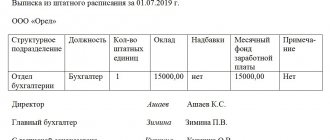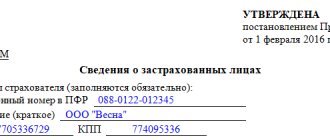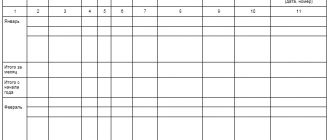All organizations must work with personnel and keep records of all orders. Orders must be recorded separately from other documentation so that the necessary information can be found at any time. For this purpose, a special book is kept for registering orders for personnel, a sample of which we will consider in this article. It is filled out in a certain way and is maintained strictly taking into account all the rules of the legislation of the Russian Federation.
The accounting procedure is determined by a decree of the Federal Archive, issued in 2000, on September 6. Article 358 establishes the procedure for maintaining documentation affecting personnel orders. The absence of such a book is a violation of the rules established by labor legislation.
What it is
A job description is an organizational and legal document that regulates the rights, duties and responsibilities of an employee when carrying out activities in a particular position.
This document specifies the functions, rights, and responsibilities performed by the employee (including responsibility for failure to perform them), and also defines the main points of interaction with colleagues in other positions. In addition, the instructions contain a list of requirements for a candidate applying for the corresponding position.
There is no unified form of job description, as well as requirements for filling it out, so the employer has the right to develop it entirely at his own discretion. The instructions can be either standard (using a template for similar organizations) or specific (describing all aspects of your activity).
Personal records log - rules for registration and completion
The process of systematizing personal files in a journal can be carried out in several ways:
- Using serial numbering of cases.
- Using an alphabetical index.
- Broken down by structural divisions of the company or job categories.
Responsibility for filling out personal files and registering them rests with the personnel department or an authorized employee who has been assigned the appropriate responsibilities by order of the manager. The logbook for registering personal files of employees, a sample of which at enterprises may have individually designed forms, is signed by the responsible person after entering information into it.
All personal files opened at the institution must be recorded in the journal. Each column must be filled out. If necessary, the form of the form can be modified - add additional cells for data or remove unnecessary information. Corrections made are reflected in a special field - “Notes”. All entries must be numbered.
The employee personal affairs log, a sample of its design, must contain information about:
- the serial number of the record being made;
- number assigned to a specific personal file;
- date of establishment of the specified personal file;
- date of closure of the case;
- FULL NAME. employee;
- worker's personnel number;
- when the closing date of the case is indicated, the reason for this action must be indicated;
- locations of cases;
- date of submission of the case to the archive;
- field for comments.
It is proposed to enter all additional information about the employee in the notes column in the employees’ personal affairs log. It is allowed not only to purchase ready-made magazine forms, but also to create them on your own. To do this, you will need to create a title page with a tabular part of the journal for entering data about employees. After printing the required number of pages, they are stapled to the title page and numbered. Be sure to glue the ends of the lacing thread together and seal it with a seal; at the end, the person responsible for keeping the journal is indicated.
The title page must contain information about the name of the enterprise, the date of opening of the journal and the end of its maintenance. All entries in the journal columns are entered in chronological order. The color of the paste can be blue, black or purple. No blots or erasures should be allowed in the journal. All errors must be crossed out and placed in brackets, and the correct data must be written next to it. You should cross out so that you can make out which word was written earlier.
Employees' personal records log: sample
| Record number | Registration number of personal file | date of registration of personal file | FULL NAME. employee | Personnel Number | Case closing date | Reason for closing the case | Date of transfer of the case to the archive | Signature of the person responsible for the management of affairs |
| Ivanov I.I. | dismissal order dated August 17, 2017 No. 48-k | Sidorova |
Features of drawing up and signing a job description
The instructions are developed on the basis of the following documents:
- qualification directory of positions for managers, specialists and other employees (approved by Resolution of the Ministry of Labor of Russia dated August 21, 1998 No. 37);
- staffing schedule;
- regulations on structural divisions;
- other organizational documents of the employer.
Job descriptions are drawn up for each position provided for in the staffing table. According to the specified document, all labor functions are evenly distributed among the employees of the organization (structural unit).
The development of the document is carried out by the head of the structural unit, and approval is carried out by the head or deputy of the organization (IP) (depending on whose subordination the structural unit is located in the position in which the instructions are being developed). The document is also endorsed by an employee of the legal service and those officials on whom the implementation of the tasks provided for in the instructions depends.
It is mandatory for the employee to familiarize himself with the job description.
Document storage requirements
The personal files of all employees who currently work at the enterprise must be kept in its personnel department, accordingly, the journal is kept there. A special fireproof cabinet is used to store them. The storage facility is kept locked and sealed.
The journal is available to the responsible employee of the HR department who maintains personal affairs and, in addition, to the head of the HR department. An authorized employee is appointed by the manager, who issues the corresponding order. Before starting work, he undergoes training. During this training, he is told about his responsibilities and the contents of the employee’s personal file, all the documents that need to be placed in it. Also, upon signature, he is introduced to the Regulations, which describe the processing of the employee’s personal data, and also contain the rules for their protection, as well as the rules for maintaining a log of the employee’s personal affairs.
If such a need arises during the performance of duties, access to the personal files of employees is also provided to the heads of the structural divisions in which they are employed. A managerial employee of this level may have the opportunity to familiarize himself with data from the personal file of a subordinate; for this he needs to contact the head of the personnel department or the head of the enterprise. Upon receipt of permission, an order of appropriate content is issued. This document serves as the basis for admission.
You should disclose only the information and provide only those documents that are required by the head of the unit and that are expressly included in his request.
It is not allowed to give him access to other documents and, especially, to the entire personal file. Also, before providing him with information, it is necessary to familiarize the head of the department with the Regulations on Personal Data of Employees, which is adopted in this company, and obtain his signature that he is familiar with this document.
The employee himself has free access to his own business. He doesn’t need anyone’s sanction to get to know him. He can receive it against signature any day he needs it. Then he can study it until the end of the working day, after which he needs to return the file to its storage location.
When an employee quits and moves to another company, it is possible to transfer the case to another company. This is carried out on the basis of a special request coming from her to the previous one, while such an obligation does not exist and the decision remains with the previous employer. When an employee retires, after some time his file is sent from the personnel department to the archive. The following periods are provided for its storage in the personnel service: three years in the general case and ten years if we are talking about civil servants.
Before sending the folder to the archive, it is stapled, assigned a number and a description is written.
The personal file compiled in this way is then sent to the archive, where it is kept for 75 years. Further, personal files are generally destroyed.
Special cases - folders with cases that relate to individuals who were leaders, received various knowledge and received state awards. Destruction is not allowed for their files; they are stored forever.
This video contains information about the personal affairs of employees.
The employee personal files log is an example of systematization of personnel appointment documentation. It is necessary to preserve the set of personal files of the organization’s employees and to implement the ability to quickly track information about the state of labor relations with a specific employee. The procedure for maintaining personal files by personnel services is mandatory for government agencies; other categories of legal entities are given the right to independently decide whether they need this type of personnel records or not.
Contents of the job description
In most cases, the job description includes the following sections:
General provisions
This section indicates the name of the position (according to the staffing table) and structural unit, subordination, the procedure for appointment and dismissal from the position, requirements for the employee holding this position, etc.
Tasks and functions
The section should contain a specific list of tasks performed by employees, for example: participation in trials, preparation of documentation, etc.
Rights
The section must specify the employee’s rights that arise when he performs his job function. For example: the right to receive information necessary to perform work.
Responsibilities
The section may include the following responsibilities: compliance with work regulations, non-disclosure of official information, etc.
Responsibility
The section prescribes the employee’s responsibility for the result of the work performed, measures to comply with safety regulations, etc.
Relationships
The section includes the features of the employee’s relationship with other structural divisions and officials.
Required details
The instructions must contain the following details:
- date and document number;
- name of the organization and place of compilation;
- visa approval;
- signature of the manager (deputy) and employee;
- approval stamp.
Find yours
Despite ongoing large-scale projects to digitize and popularize archival documents from the Great Patriotic War, most of them still remain little-known and difficult to access. Using the example of documents from the Central Archive of the Ministry of Defense of the Russian Federation and some other archives, we want to tell you about historical papers that continue to be stored on archival shelves, but with the right approach can become a real treasure for preserving and restoring the history of your family
.
Officer's service record card
Perhaps you have already heard the short abbreviation Criminal Procedure Code? An officer's service record card is the first piece of news from the past that a researcher should pay attention to. This is a small (usually A4 sheet, sometimes half of it), but often very informative document.
The front side of an officer's service card. Separate file cabinets have also been kept for the political composition, as well as Air Force personnel, in the Central Archive of the Ministry of Defense (TsAMO) in Podolsk. In the latter case, you can count on cards issued not only for officers, but also for non-commissioned officers
If the card was filled out in good faith by responsible comrades, then in it you, depending on the form of the form (there were several), can find the date and place of birth, nationality, social and marital status, years of birth of children, place of conscription, awards, party number and military ID, years of rank and education information. Also in the Code of Criminal Procedure you can find out about all the positions of an officer from the very beginning of service in the Red Army. If you are really lucky, then in the upper left corner of the card there will be a small photograph of an ancestor measuring approximately 3x4 cm.
Reverse side of an officer's service card. The service record is an excellent starting point for studying the combat path of the units and formations in which the officer served
If a successful combination of circumstances occurs, you can familiarize yourself with the Code of Criminal Procedure already on the day of arrival at the archive. The good thing about the service record card is that you don’t need documents confirming your relationship with the officer to review it, but these papers will come in handy if you want to gain access to the next, more informative document. Most often, to confirm a relationship, a chain of birth certificates of relatives connecting you and the serviceman of interest is sufficient. So, in the simplest case, if you are looking for information about your paternal grandfather, it is enough to attach copies of two birth certificates - yours and your father's. If it is not possible to carry out archival searches personally, a notarized power of attorney in the name of the researcher to whom this problem is delegated will also be necessary.
Private bussiness
Perhaps nothing tells more about a person (including the person himself) than his personal business. This voluminous A4 folder is a real “grail of knowledge” about the officer. The military must be given credit for collecting and storing detailed data. Amazing discoveries will almost certainly await you inside, and sometimes... not very pleasant ones.
On the left is the cover of the officer’s personal file, on the right is a page from it with a list of places of work before serving in the army
So what can you find in it?
The file contains a detailed autobiography of a person (in the case of a long military career, more than one), written in his own hand on 3-4 sheets. Many of us have encountered the fact that relatives who fought are not inclined to talk in detail about certain periods of their lives; they often laugh it off or answer in general terms. In your autobiography you will find a list of all places of service (military and civilian) from which you can restore your biography.
In the personal file there are sections in which information about the level of proficiency in foreign languages, scientific works and publications in periodicals was recorded. Of particular value to many relatives may be the section about parents and their life before the 1917 revolution.
On the left is a fragment of an autobiography from the officer’s personal file, on the right is a certification for suitability for the position held. Over a long period of service, up to a dozen such documents could also accumulate in a personal file.
Often attached to the personal file are service and party characteristics, applications for the next rank or position, a copy of the education diploma, the school is indicated, and there are even medical documents with details of injuries and treatment. Also in the file there is a card of penalties and rewards with a description of when and for what. The cover itself usually includes a large, clear photograph of a person, up to 9x12 cm in size.
Registration of privates and sergeants
We have more or less sorted out the documents for the command staff, but what to do with the privates and sergeants who did not have personal files and do not have service records? Various alphabetical and nominal lists of units and formations of the Red Army come to the rescue.
Alphabet book of privates and sergeants
- the source is simple and laconic, but the information from it is invaluable for further research. It included the full surname, first name and patronymic of the fighter, position or military specialty, indicated the unit, as well as (which is very important) the page number with information about the fighter in the personnel record book, which we will now talk about.
Cover and page from the book of alphabetical registration of privates and sergeants of the 335th Guards Rifle Regiment from the funds of TsAMO
Registration book for privates and sergeants, or staff book
- this, of course, is not a personal document, but it, as a rule, contains a large amount of personal information about ordinary soldiers.
Sometimes they were drawn out by hand and kept in any form, but in such documents you can find the full last name, first name and patronymic, position, rank, year and place of birth, home address before conscription into the army, military registration and civilian specialty (even the address of the last place of work), date of taking the military oath.
Page spread of the nominal list of privates and sergeants of the 774th Infantry Regiment (TsAMO)
Party affiliation was also indicated (usually with the party card number, which, as we will see later, is important), nationality and level of education, information about participation in past wars, injuries and awards, marital status and immediate relatives. There was a column with information about where the soldier came from to the regiment, whether he was captured, and whether there were any relatives in the occupied territory. If the person had already left the unit, then the last column indicated the date and reason for departure, as well as the order number, which may be useful for further search.
This book was checked by the unit headquarters with other documents at least once a month, and changes had to be made on the day the order was issued.
Some historians agree that the service records mentioned above were issued not only for officers, but also for all ordinary military personnel. However, allegedly already in the 50s of the last century they were all destroyed. So, for many, data from various alphabetical and official books can become the only lead to establishing the history of a soldier. Documentary proof of relationship is not required to work with these documents.
"Tailoring statements"
Separately, it is worth talking about various supporting documents stored in the funds of military units. Among researchers working in personnel archives, the term “footcloth lists” has long been firmly attached to such documents - these are, as a rule, various kinds of lists for the issuance of clothing allowances (the same footcloths, felt boots, gas masks, etc.), about vaccinations received, etc. Among other “footcloth statements”, financial documents on the issuance of salary are the best preserved.
Distribution sheet for the issuance of salary to the commanding staff of the 42nd Guards Cavalry Regiment for September 1943
At first glance, these are not the most informative documents, but in the archival funds of many regiments and divisions these are the only documents with surname lists of personnel, first deposited in the archives after the war, and then not destroyed after the expiration of the storage period, which was initially set at only 5– 10–15 years. With such statements, you can confirm, first of all, the very fact of a person’s service in a military unit, as well as find out how much money a particular soldier or commander received, how much he sent to his family, and compare these amounts with the prices of those years. But think of it more as a bonus.
It is much more important that next to the desired surname you will see many others. Just as in the document, these people shared the hardships of war together, shoulder to shoulder, and fought in the same regiment, battalion or even platoon. These names provide a unique opportunity to look at the fate of a particular unit from dozens of eyes and allow you to increase the number of sources of information hundreds of times. Some of these people were friends and shared shag with your ancestor in the trench; award certificates and information about death were also written on them. This data can seriously help in finding details about your relative’s combat path. Documentary proof of kinship is not required to work with most “footcloth statements”.
Party documents
Some of the Soviet soldiers and commanders were members and candidate members of the All-Union Communist Party (Bolsheviks) - at the beginning of the war there were about 650,000 communists and, despite huge losses, by the beginning of 1945 their number had grown to more than three million - almost six once. If your ancestor was a member of the CPSU(b), then several additional sources of biographical data open up. Most of the documents relating to party registration are stored in RGASPI - the Russian State Archive of Socio-Political History.
Report card and registration form.
For each candidate joining the party, the political department of the military unit created a report card and a registration form. Then, upon successful completion of the candidate term, a similar procedure was repeated when exchanging the candidate card for a party card. On the report card - a small piece of A6 cardboard - you can see a photograph of a relative, full name. and year of birth, personal signature and name of the organization that issued the party card - i.e., military unit, which can be used as a basis for further search.
Report card and registration form created upon joining the CPSU(b)
In the registration form - an A4 sheet - as many as 25 columns were filled out about the past of the party member. In the document you can find social status, parental occupation before and after 1917, level of education and names of educational institutions, all places of civil and military service, language proficiency and scientific works, awards, criminal records and more. In terms of thoroughness of completion, the registration form of a member of the CPSU (b) most often surpasses the registration and service card of an officer from TsAMO.
However, it should be taken into account that registration forms and report cards in RGASPI are not kept by full name. party member, but by party card number. Worse, when only the time and place of joining the party is known, a search without these details is extremely difficult.
The case of admitting a candidate to membership in the CPSU(b).
Unlike the personal file of the commander of the Red Army, this document was created regardless of military rank and position, and in terms of information content it is in many ways not inferior to it. In the application for admission to the party, you can find a military description that sheds light on interesting episodes in which a person showed courage, heroism or military ingenuity - invaluable material for family history. Often attached are several extracts from the minutes of meetings of the Komsomol bureaus, which record the ancestor’s answers to tricky questions about the history and politics of the Bolshevik Party.
Party recommendation and extract from the minutes of a meeting of the Komsomol organization
There is also a questionnaire in the folder, which largely duplicates the information from the registration sheet, but may contain additional important biographical details. Particularly interesting are party recommendations written by senior comrades who vouched for your relative with their name and place in the CPSU(b). After reading, you will probably feel an even greater sense of pride in your ancestor.
Medical documents
The military medical archive in St. Petersburg (officially it has the status of a Branch of the Central Archive of the Ministry of Defense of the Russian Federation) does not have its own reading room, and even the appearance of the original documents stored there is known only to a few. But if your soldier or officer was in the hospital during the war after being wounded or ill, it is worth making a request to this rather closed, but extremely useful institution for research. In order not to receive a blank reply, it is highly advisable to indicate the military unit in which he served.
Information from the archive can help clarify a person’s position and department, dates of hospitalization and the place in which he was treated, and the given dates will provide food for thought and tips for further searches.
Official response from the military medical archive to a request made by mail
These are the initial directions of the search. Of course, in addition to the documents described, there were dozens of different papers that could be preserved in federal and local archives, as well as in military registration and enlistment offices.
Completed job description samples
Below are examples of filling out job descriptions:
- job description of the General Director ();
- job description of an accountant ();
- job description of a specialist ();
- manager's job description ().










